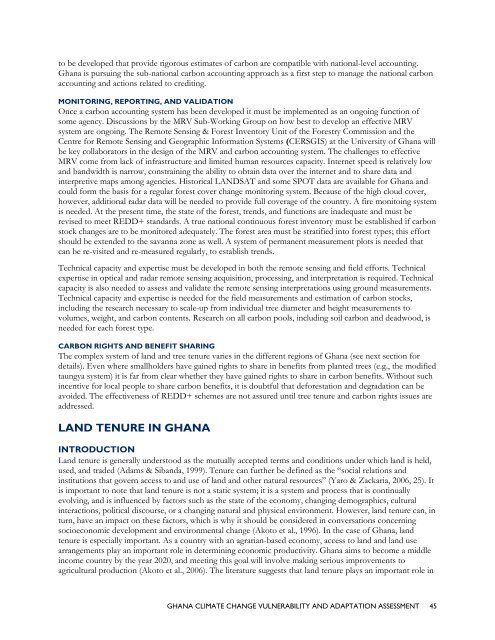ghana climate change vulnerability and adaptation assessment
ghana climate change vulnerability and adaptation assessment
ghana climate change vulnerability and adaptation assessment
- No tags were found...
You also want an ePaper? Increase the reach of your titles
YUMPU automatically turns print PDFs into web optimized ePapers that Google loves.
to be developed that provide rigorous estimates of carbon are compatible with national-level accounting.Ghana is pursuing the sub-national carbon accounting approach as a first step to manage the national carbonaccounting <strong>and</strong> actions related to crediting.MONITORING, REPORTING, AND VALIDATIONOnce a carbon accounting system has been developed it must be implemented as an ongoing function ofsome agency. Discussions by the MRV Sub-Working Group on how best to develop an effective MRVsystem are ongoing. The Remote Sensing & Forest Inventory Unit of the Forestry Commission <strong>and</strong> theCentre for Remote Sensing <strong>and</strong> Geographic Information Systems (CERSGIS) at the University of Ghana willbe key collaborators in the design of the MRV <strong>and</strong> carbon accounting system. The challenges to effectiveMRV come from lack of infrastructure <strong>and</strong> limited human resources capacity. Internet speed is relatively low<strong>and</strong> b<strong>and</strong>width is narrow, constraining the ability to obtain data over the internet <strong>and</strong> to share data <strong>and</strong>interpretive maps among agencies. Historical LANDSAT <strong>and</strong> some SPOT data are available for Ghana <strong>and</strong>could form the basis for a regular forest cover <strong>change</strong> monitoring system. Because of the high cloud cover,however, additional radar data will be needed to provide full coverage of the country. A fire monitoing systemis needed. At the present time, the state of the forest, trends, <strong>and</strong> functions are inadequate <strong>and</strong> must berevised to meet REDD+ st<strong>and</strong>ards. A true national continuous forest inventory must be established if carbonstock <strong>change</strong>s are to be monitored adequately. The forest area must be stratified into forest types; this effortshould be extended to the savanna zone as well. A system of permanent measurement plots is needed thatcan be re-visited <strong>and</strong> re-measured regularly, to establish trends.Technical capacity <strong>and</strong> expertise must be developed in both the remote sensing <strong>and</strong> field efforts. Technicalexpertise in optical <strong>and</strong> radar remote sensing acquisition, processing, <strong>and</strong> interpretation is required. Technicalcapacity is also needed to assess <strong>and</strong> validate the remote sensing interpretations using ground measurements.Technical capacity <strong>and</strong> expertise is needed for the field measurements <strong>and</strong> estimation of carbon stocks,including the research necessary to scale-up from individual tree diameter <strong>and</strong> height measurements tovolumes, weight, <strong>and</strong> carbon contents. Research on all carbon pools, including soil carbon <strong>and</strong> deadwood, isneeded for each forest type.CARBON RIGHTS AND BENEFIT SHARINGThe complex system of l<strong>and</strong> <strong>and</strong> tree tenure varies in the different regions of Ghana (see next section fordetails). Even where smallholders have gained rights to share in benefits from planted trees (e.g., the modifiedtaungya system) it is far from clear whether they have gained rights to share in carbon benefits. Without suchincentive for local people to share carbon benefits, it is doubtful that deforestation <strong>and</strong> degradation can beavoided. The effectiveness of REDD+ schemes are not assured until tree tenure <strong>and</strong> carbon rights issues areaddressed.LAND TENURE IN GHANAINTRODUCTIONL<strong>and</strong> tenure is generally understood as the mutually accepted terms <strong>and</strong> conditions under which l<strong>and</strong> is held,used, <strong>and</strong> traded (Adams & Sib<strong>and</strong>a, 1999). Tenure can further be defined as the “social relations <strong>and</strong>institutions that govern access to <strong>and</strong> use of l<strong>and</strong> <strong>and</strong> other natural resources” (Yaro & Zackaria, 2006, 25). Itis important to note that l<strong>and</strong> tenure is not a static system; it is a system <strong>and</strong> process that is continuallyevolving, <strong>and</strong> is influenced by factors such as the state of the economy, changing demographics, culturalinteractions, political discourse, or a changing natural <strong>and</strong> physical environment. However, l<strong>and</strong> tenure can, inturn, have an impact on these factors, which is why it should be considered in conversations concerningsocioeconomic development <strong>and</strong> environmental <strong>change</strong> (Akoto et al., 1996). In the case of Ghana, l<strong>and</strong>tenure is especially important. As a country with an agrarian-based economy, access to l<strong>and</strong> <strong>and</strong> l<strong>and</strong> usearrangements play an important role in determining economic productivity. Ghana aims to become a middleincome country by the year 2020, <strong>and</strong> meeting this goal will involve making serious improvements toagricultural production (Akoto et al., 2006). The literature suggests that l<strong>and</strong> tenure plays an important role inGHANA CLIMATE CHANGE VULNERABILITY AND ADAPTATION ASSESSMENT 45
















